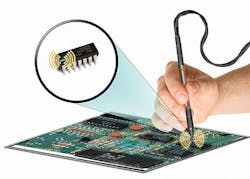Northrop Grumman zeroes-in on technologies to protect military from counterfeit electronics
ARLINGTON, Va., 11 July 2016. Defense microelectronics experts at the Northrop Grumman Corp. Mission Systems segment in Linthicum, Md., are moving forward on a U.S. military research initiative to safeguard the military electronics supply chain from substandard used and counterfeit electronics.
Officials of the U.S. Defense Advanced Research projects Agency (DARPA) in Arlington, Va., announced a $7.3 million contract option on Friday for the second phase of the DARPA Supply Chain Hardware Integrity for Electronics Defense (SHIELD) program.
In the program's second phase Northrop Grumman engineers will continue work on a tool to verify the trustworthiness of protected electronic components without disrupting or harming the system into which they have been designed.
Used and counterfeit electronic components are widespread throughout the defense supply chain, DARPA officials say. Suspect electronic components present a critical risk in military systems where a malfunction of a single part could lead to system failures that can put warfighter lives and missions at risk.
In the SHIELD program's first phase Northrop Grumman experts worked to develop a 100-by-100-micron component, or dielet, that authenticates electronics components. The dielets have encryption engines and sensors to detect tampering that affix to electronic components like microchips.
The SHIELD program's goal is to provide 100 percent assurance against recycled components that are sold as new; unlicensed overproduction of authorized components; test rejects and sub-standard components sold as high-quality; parts marked with falsely elevated reliability or newer date of manufacture; low-quality clones and copies that may include hidden functionality; and components that are covertly repackaged for unauthorized applications, DARPA officials say.
SRI International in Menlo Park, Calif., and the Charles Stark Draper Laboratory in Cambridge, Mass., joined Northrop Grumman on the DARPA SHIELD program's first phase. The three companies won SHIELD phase-one contracts in January 2015.
"SHIELD demands a tool that costs less than a penny per unit, yet makes counterfeiting too expensive and technically difficult to do,” says Kerry Bernstein, the SHIELD program manager at DARPA.
"The dielet will be designed to be robust in operation, yet fragile in the face of tampering," Bernstein says. "What SHIELD is seeking is a very advanced piece of hardware that will offer an on-demand authentication method never before available to the supply chain."
Related: SRI, Northrop, and Draper to safeguard military from counterfeit electronics
Northrop Grumman, Draper, and SRI experts in phase one developed dielets that can be inserted into an electronic component’s package at the manufacturing site or affixed to existing trusted components, without any alteration of the host component’s design or reliability.
The companies designed dielets with no electrical connections to the host component, such that authenticity testing can be done anywhere with a handheld or automated probes. After a scan, an inexpensive appliance like a smart phone will upload a serial number to a central, industry-owned server. The server sends an unencrypted challenge to the dielet, which sends back an encrypted answer and data from passive sensors—like light exposure—that could indicate tampering.
The contract option announced Friday brings the total cumulative face value of the company's SHIELD contract to $19.6 from $12.3 million. On the second phase Northrop Grumman will do the work in Linthicum, Md.; Albuquerque, N.M.; Santa Clara, Calif.; Reston, Va.; Lubbock, Texas; and Atlanta, and should be finished by January 2018.
For more information contact Northrop Grumman Mission Systems online at www.northropgrumman.com, or DARPA at www.darpa.mil.

John Keller | Editor
John Keller is editor-in-chief of Military & Aerospace Electronics magazine, which provides extensive coverage and analysis of enabling electronic and optoelectronic technologies in military, space, and commercial aviation applications. A member of the Military & Aerospace Electronics staff since the magazine's founding in 1989, Mr. Keller took over as chief editor in 1995.

